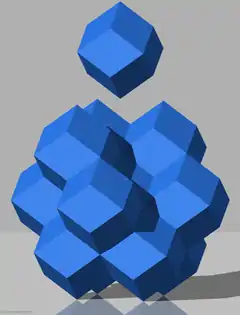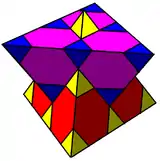Trigonal trapezohedral honeycomb
The trigonal trapezohedral honeycomb is a uniform space-filling tessellation (or honeycomb) in Euclidean 3-space. Cells are identical trigonal trapezohedron or rhombohedra. John Horton Conway calls it an oblate cubille.
| Trigonal trapezohedral honeycomb | |
|---|---|
| (No image) | |
| Type | Dual uniform honeycomb |
| Coxeter-Dynkin diagrams | |
| Cell |  Trigonal trapezohedron (1/4 of rhombic dodecahedron) |
| Faces | Rhombus |
| Space group | Fd3m (227) |
| Coxeter group | ×2, [[3[4]]] (double) |
| vertex figures | |
| Dual | Quarter cubic honeycomb |
| Properties | Cell-transitive, Face-transitive |
Related honeycombs and tilings
This honeycomb can be seen as a rhombic dodecahedral honeycomb, with the rhombic dodecahedra dissected with its center into 4 trigonal trapezohedra or rhombohedra.
 rhombic dodecahedral honeycomb |
 Rhombic dodecahedra dissection |
 Rhombic net |
It is analogous to the regular hexagonal being dissectable into 3 rhombi and tiling the plane as a rhombille. The rhombille tiling is actually an orthogonal projection of the trigonal trapezohedral honeycomb. A different orthogonal projection produces the quadrille where the rhombi are distorted into squares.
 |
 |
Dual tiling
It is dual to the quarter cubic honeycomb with tetrahedral and truncated tetrahedral cells:
References
- John H. Conway, Heidi Burgiel, Chaim Goodman-Strauss, (2008) The Symmetries of Things, ISBN 978-1-56881-220-5 (Chapter 21, Naming the Archimedean and Catalan polyhedra and tilings, Architectonic and Catoptric tessellations, p 292-298, includes all the nonprismatic forms)
- Branko Grünbaum, Uniform tilings of 3-space. Geombinatorics 4(1994), 49 - 56.
